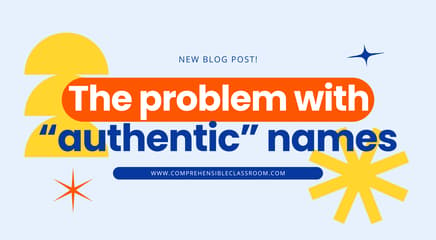When I first ditched the textbook, Weekend Chats was one of the very first routines that I learned about and started using in class. I was introduced to it by Michele Whaley, and I remember reading about it on Ben Slavic's blog soon thereafter. I used Ben's idea of having students illustrate posters of places around the community to hang up in my classroom and reference as we did the Weekend Chats each Monday. My sixth and seventh graders illustrated them, and I kept them on the walls until that group of students finished my program. All that to say that blogging about Weekend Chat brings up some wonderful memories. It connected me with my students, and that is what I lived for. Man, I miss my students!!
WHAT IS A WEEKEND CHAT?
Weekend Chats are pure, unadulterated Personalized Questions and Answers. A Weekend Chat is a time for you to talk with your students about what happened in their lives (and yours!) over the weekend. A Weekend Chat is a teacher-led discussion, where students are sharing information about their lives (sometimes real, sometimes invented) in their responses. When a student says something, the teacher typically reflects what he or she said back to the class (with attention to accuracy and comprehensibility), and then asks for more information from that student or for reactions from classmates.
A Weekend Chat typically begins with a really simple question: "Where did you go last weekend?". I like this question best--especially at the beginning of the year--because it is a much easier question to understand than, "What did you do last weekend?", and the same verb will be used in the answer as was used in the question. You'll still likely get into what students did wherever they went, but it gives the conversation a more solid starting point.
WHY I LOVE WEEKEND CHAT
Weekend Chats open a window into students' lives; if you are really fortunate, they open a door. A positive student-teacher connection and student-student connection are critical to a healthy class culture, and activities like Weekend Chats that allow you to get to know each other can help create and strengthen these connections.
Another reason that I love Weekend Chats is that they taught me to not be afraid of using grammar that my students hadn't studied. Prior to ditching my textbook and diving head-first into Comprehension Based teaching, I would have thought it a cruel and unusual form of punishment to ask my students to participate in a conversation with me in the past tense when we had never even studied the past tense. Weekend chats proved to me that language is language, and students will only look differently at different verb forms if you tell them to.
For those of you familiar with the Somos curriculum, you know that Level 1 is primarily written in the present tense and Level 2 is primarily written in the past tense. This was done purposefully to align with the textbook that most teachers in my school district were following. Weekend chats were a way for me to give my students extensive exposure to the past tenses, even in Level 1. (Really, a Weekend Chat is just the "went" lesson repeated every week during the school year.)
TWISTS ON WEEKEND CHAT
We didn't do Weekend Chats every Monday, but we did do them many Mondays. Some teachers have this amazing ability to follow the exact same routine each week without inspiring rebellion from their students. In fact, some teachers are able to do a weekend chat on Monday and keep the conversation going all week! Weekend Chats are the curriculum for some teachers!!
Not me. I can't for the life of me figure out how to sustain it. And just in case you are like me, here are 10 twists on Weekend Chats that I have pulled together to help you sprinkle this routine into your course with confidence, all year long!
TWIST #1: SUPERLATIVES
I have to start with this one because it is my inspiration for the post! Allison Lewis got me thinking about Weekend Chats when she blogged about this twist on Sunday, and several of the other ideas on this post were shared by other teachers in comments on my Facebook page in response to her post!
Allison gave her students some processing time (which is really helpful for anyone, but especially for classes that aren't particularly talkative!) by having her students write down some of the things they did over the weekend first. Then, in groups, she had them share their lists and determine together which person in the group had the busiest and which person had the laziest weekend. Finally, she had each group share out their findings. Read the detailed sequence of activities on Allison's blog here.
This activity is similar to a collective interview and shares some qualities with the Kagan Team Windows structure. If you find success with Allison's Task, check out those posts as well!
TWIST #2: CHECK YES OR NO
If the idea of throwing out an open ended question to your students and just hoping that they say something that you can keep comprehensible to the entire class makes your palms start to sweat, then giving students a list of options to choose from might give you the confidence you need to tackle a weekend chat. This also works well for classes that are not eager to answer questions in class discussion!
When you make a list, try to include some things that surely everyone did (ex: slept, woke up on Sunday morning). Beyond that, be thoughtful about the activities that you include on the list. Consider including activities that do not create division or perceived division among your students and that uphold class values. Things like:
- I helped another person this weekend.
- I saw something inspiring this weekend.
- I said something kind this weekend.
- I sang a song this weekend.
- I volunteered in my community this weekend.
- I spent time in nature this weekend.
- I read something this weekend.
- I learned something new this weekend.
- I overcame a fear this weekend.
- I took care of an animal or person this weekend.
Each of these "Yes or No" activities is a starting point. If you are comfortable leading a conversation, you will be able to spend a long time connecting with your students and connecting them with each other with these simple statements.
To extend this activity, consider creating using students' data to create a Bulletin Board Bar Graph!
If you aren't comfortable leading a conversation, I recommend asking yourself Why not? There are many reasons that teachers might try to avoid free-flowing class discussion in the target language. One factor is perceived ability to help students comprehend the discussion, and the other is a communication barrier for the teacher. At OFLA last month, I was reminded in one of Gary DiBianca's workshops that we can get better at thinking on our feet and making choices quickly about the direction of conversation. Gary led the workshop participants through a series of common Improv games that helped us exercise our ability to think about the same idea from different angles, to keep a conversation or storyline moving forward, and to use our bodies and our voices to more effectively communicate messages to our students. If this sounds like professional development that you need, reach out to Gary or catch him at one of the summer conferences!
TWIST #3: FLAT STANLEY
My great friend Christina Bacca shared this idea in a facebook comment! Christina's classes have a mascot (yes!! great idea!!), and each weekend the mascot gets to go home with a different student. The student must take pictures of the mascot's adventures during the weekend. Come Monday, the class gets to talk about what the MASCOT did over the weekend!
This twist is marvelous. It completely releases students of any real or perceived pressure to share information about themselves, it removes any kind of posturing that can come from comparing one student's life to another's, and it gives you something concrete to talk about (photos!).
TWIST #4: TWO TRUTHS AND A LIE
Everyone in the class writes down three statements: two things that they DID do over the weekend, and one statement that they didn't. One at a time, pull a student up to the front of the class and either read their statements for them (with attention to accuracy and comprehensibility) or have them read their own statements aloud. Then, have the class guess which one is the intruder. You can also use common icebreaker as an activity to review a story or text with your classes!
TWIST #5: FIND SOMEONE WHO
Find someone who is one of my go-to Kagan Cooperative Learning structures--and certainly you have participated in a variation of this popular structure at a professional development event in your time as a teacher!
Create a list of activities that students might have done over the weekend (with attention to the same considerations as in the "Check yes or no" twist). Write them out in list form, or place them in a grid--like a BINGO board (Allison Wienhold has created several for Spanish). Then, have students interview their classmates, asking them whether or not they did the activities listed. Their goal is to FIND SOMEONE WHO did each one of the activities listed and to collect a signature for each item as evidence.
As with most output in a Comprehension Based language class, the purpose of this activity is to generate input. Once students have interacted with each other for a short period of time (five minutes or less!!), they are now equipped to share information in a class discussion about who did or didn't do different activities.
Here is an example of what getting students to share out their findings could look like:
Teacher: Class, who learned something new this weekend?
Destiny: Nick!
Teacher: Destiny, you talked to Nick?
Destiny: Yes
Teacher: Nick, did you talk to Destiny?
Nick: Yes
Teacher: Destiny, Nick said that he learned something new?
Destiny: Yes
Teacher: Class, did Nick say to anyone else that he learned something new?
Lorenzo: Me
Teacher: Lorenzo, Nick told you that he learned something new?
Lorenzo: Yes
Teacher: Nick, did you learn something new this weekend?
Nick: Yes
Teacher: Nick, what did you learn this weekend?
You can be much more direct, or you can ham it up and draw out the conversation as I showed in the example. Play off what your students enjoy and respond to.
TWIST #7: RUMOR HAS IT
I love making stuff up--as in fibbing. I have an alter ego that is really just my normal ego named "Trickster Martina". And Trickster Martina's favorite adaptation of Weekend Chat is Rumor Has It! I have written about my Rumors lesson before, so I'll spare you the nitty gritty. This is a completely fictitious version of Weekend Chat, where you are not talking about what students did...you are making up what they did. The more preposterous, the better!
TWIST #8: CHARADES OR PICTIONARY
Want to up the fun factor to ANY lesson? Instead of coming right out and telling students a piece of information...draw it or act it out! There is something wonderfully fun that comes with the negotiation of meaning created by an illustration or a gesture. You can have students draw a picture in response to one of your questions about their weekends (What problem did you solve this weekend? or even better...What problem did you cause this weekend?), or they could act it out individually in a group.
As always, your role as the teacher is to guide and narrate students' ideas as they are injected into the discussion. Keep the conversation moving forward, and keep it comprehended.
TWIST #9: FOUR CORNERS
Designate each corner of your room as a time period or frequency term. For example, "In the Past", "Never", "Last Weekend", and "Today". Make a statement about things students might have done over the weekend, such as, "I heard a new song" or "I visited a friend". Students then move to the corner that corresponds to when they did it. Once students have a place, you can ask follow-up questions to compare students' responses within groups and also between groups.
TWIST #10: SELFIES
I was never on social media with my students, but I know that a lot of teachers are! This works particularly well for those teachers, but the rest of us can find workarounds. Simply have students send you selfies (or pictures that aren't selfies--all school-appropriate, of course!), and project them for the class as a starting point for discussion. Choose the pictures that you use as a basis for class discussion thoughtfully, considering what messages you might be sending to all students in the class. To the extent that you are able, never showcase a photo that would make a student feel left-out or less-than.
Instead of showing the picture to the students first, take this hint from Marianne van Klaveren and tell students about the picture. Then have them guess who they think submitted the picture before finally revealing it to the class!
Have an idea to share?
Leave it in the comments! Looking for more ideas? Check out my Weekend Chat board on Pinterest!









